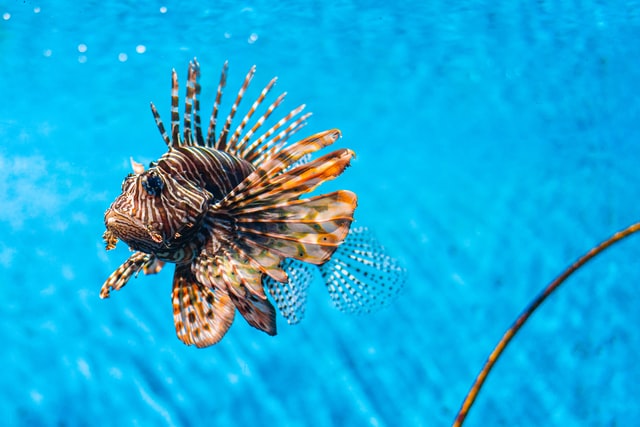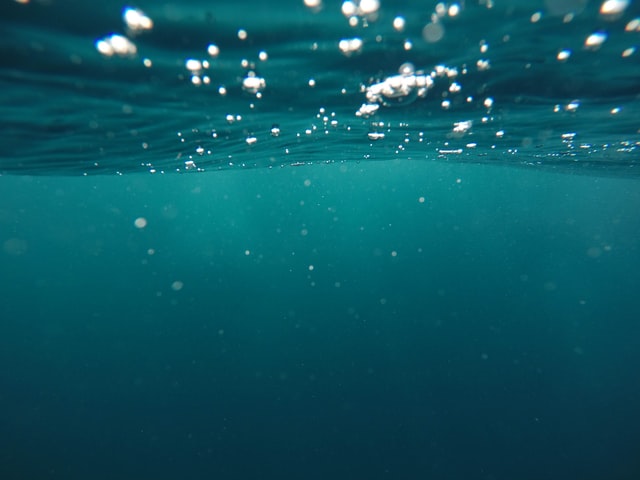The lionfish is a species unlike any other, with its one feet long, venom spines, and striped coloring. The lionfish is a poisonous species of fish. Lionfish are easily identified by their distinct look among the rocks and reefs where they are most usually seen.
In addition to their massive, frightening spines, lionfish have a brilliant red and white striped coloring that serves as a defense against predators. Many people worry if this fish is poisonous. You’ve come to the proper place if you’re one of these folks.
Lionfish – Are they Deadly?

Due to their strong venom, lionfish can be hazardous to humans, however, stings are rare and seldom deadly. A lionfish sting, on the other hand, is likely to cause some undesirable after-effects. Due to the fact that lionfish are preying on marine species, there have been happenings of hostility toward divers and fishermen.
However, such demeanor is considered to be simply defensive, with the fish employing its fatal spines to guard off individuals it senses as a threat. To protect yourself from their poison, you should keep a safe distance from them before things get out of hand.
In-depth Information about the Lionfish

➖Native Home
The lionfish’s range extends from Australia’s western side and east of Malaysia to French Polynesia and Pitcairn of the United Kingdom, all of Japan and Korea’s southern side, and south to Lord Howe Island and the Kermadec Islands of New Zealand.
➖Non-Native Home
Lionfish have been spotted along the southern coast of the United States, from Florida to North Carolina. The first sighting of it was recorded in South Florida waters in 1985, with many more sightings happening until the species was recognized as established in the early 2000s.
➖Habitation
Lionfish may be found in almost all coastal habitat types found in warm tropical seas. It has been discovered in depths ranging from 1 to 300 feet.
➖Aquatic Purpose
Lionfish are sluggish and visible, so they must depend on their distinctive color and fins to deter would-be predators. They are currently among the top predators in several Atlantic coral reef habitats. Lionfish devour about 50 different types of fish, including several that are commercially and environmentally significant.
➖Demeanor
Lionfish are supposed to be nighttime hunters, yet they have been spotted in the Atlantic with full tummies during the day. They move by softly oscillating the dorsal and anal fins’ delicate rays. During the day, they can be found hiding on ledges and cracks among the rocks and corals.
➖Importance
Even though the lionfish have been utilized as a sustenance source in their natural habitat, they are significantly more substantial commercially in the aquarium trade. Lionfish are highly popular and common aquarium fish, particularly in the United States.
Vital Things to Know about the Lionfish

Although the lionfish is visually stunning, there is much more to this enigmatic species.
‼️Their Spines are Venomous
The venom glands are placed within two grooves on the spines, which must be pierced in order for the poison to be transferred to a human. A sting may be excruciatingly painful. If you have been stung by it, get medical assistance right once.
‼️They Ambush their Prey
Lionfish eat mostly tiny fish. They are slow-moving predatory animals that creep up on their prey and consume it completely with their huge jaws. Some species have been regarded as herding targets into an appropriate posture with their pectoral fins.
‼️They have Thousands of Babies
Mature lionfish may spawn all year, and a single female can lay tens of thousands of eggs in a single spawn. The males will darken in hue, while the females will lighten. Males utilize their spines and fins in a visual show to frighten opponents and entice possible mates.
While climbing gently, the male and female will orbit each other. The female will unleash her eggs just before getting to the surface, and the male would turn upside down to impregnate them.
‼️They can Survive without Eating for a Long Time
When food is insufficient, a lionfish’s metabolism can effectively halt. Lionfish may go for up to three months without feeding and only lose 10% of their body mass. Obese lionfish have been discovered with their internal organs completely coated in fat. In addition, these lionfish are so obese that they have liver disease.
Problems Lionfish Pose in the Wild
Lionfish are a major source of worry in areas where unscrupulous aquarists have introduced them. Indeed, experts have labeled them as one of the most violently invasive species on the globe, owing to the amount of damage they are causing to the Atlantic and Mediterranean reef systems.
Lionfish eat reef fish. And because they are no natural predators in these waterways, their numbers are increasing at an uncontrollable rate, with the potential to do catastrophic harm to local ecosystems in the coming years.
And because invasive lionfish represent a danger to natural ecosystems and local fishing businesses, severe measures are being attempted to reduce their populations.
Things to Do if Stung by a Lionfish

A lionfish sting may be excruciatingly painful. If you’ve been stung by a lionfish, treat the wound as quickly as possible.
✔️First Step
Extract the spine fragments. After a sting, portions of their spine may stay in the skin. Remove this alien stuff with care.
✔️Second Step
Soap and freshwater should be used to clean the area. If you have a first-aid kit, antibacterial towels can be used to wash the wound.
✔️Third Step
Stop the bleeding. Directly apply pressure to the wound using a clean towel or cloth. This will aid in the clotting of your blood and the cessation of any bleeding.
✔️Fourth Step
Apply heat to aid in the breakdown of the venom. Use as much warmth as you can stand without getting burned. Bring a thermos of hot water or a reusable heat pack in your maritime first aid kit.
✔️Fifth Step
Take pain relievers. A lionfish sting can be excruciatingly painful, so use an over-the-counter pain killer to alleviate the discomfort. Ibuprofen and Tylenol are examples of such medications.
✔️Sixth Step
After that, put a topical antibiotic treatment to the affected area. Then, to limit the risk of infection, place a bandage around the incision.
✔️Seventh Step
To minimize swelling, apply ice or a cold pack. This should be done after the initial heat therapy.
✔️Eight Step
Seek medical treatment if the discomfort is worse than you thought. Some people may not require medical attention after being stung by a lionfish. If the sting produces extreme pain, you will want a stronger pain reliever. Infection also occurs if other microorganisms enter the body through the skin.
Surprising Advantages of Eating Lionfish

👍It is Sustainable
Lionfish are the perfect sustainable seafood since they are an exotic species whose population is being reduced. They are invasive, and the objective is to get rid of as many of them as possible.
There are rising strains that a growing population is exerting on our finite ocean supply with significant commercial overfishing, yet there is no need for guilt when it comes to lionfish.
👍It Provides People Employment
Since lionfish are seldom captured on hook and line, the majority of lionfish are now taken by divers utilizing short pole spears and diving gear. Lionfish hunting is time-consuming, and no major commercial vessels are scooping up vast numbers of lionfish.
While many lionfish are caught as bycatch in lobster traps, the great majority of commercially caught lionfish are caught by individual divers looking to augment their income.
👍It is Healthy
Lionfish is a heart-healthy fish to eat since it has a greater percentage of Omega 3 fatty acids and a lower amount of Omega 6 fatty acids.
All of this benefits your cholesterol since the fatty acids in lionfish aid to reduce your bad cholesterol while increasing your good cholesterol. This implies that lionfish is one of the safest options available.
👍It Protects the Reef
Every lionfish taken from the reef to be served as supper is not out there devouring other critical fish that contribute to the ecosystem’s balance. It has been shown to consume more than 70 various kinds of our native species, making them one of the most serious dangers to marine ecology in the western Atlantic.
👍It Tastes Good
Lionfish is not only good for the ecosystem, but it is also one of the most delicious fish on the reef. It has a white, flaky flesh akin to snapper and is far superior to tilapia. Since lionfish has a rather neutral flavor, it may be cooked in any way you choose.
Other Venomous Fish in the Sea

As exciting as diving and swimming with marine creatures might be, it is also crucial to be aware of the possible risks in the water.
🐠Puffer Fish
An extremely dangerous chemical is found in puffer fish. The toxin attacks the victim’s brain, causing weakness, paralysis, and death. Due to their spiky skin, these fish are highly hardy physically, and they have strong survival instincts. They are among the most deadly fish in the world’s waters.
🐠Red Lionfish
The Red Lionfish is well-known for its poisonous fin spines, which may cause severe wounds. When disturbed, the fish stretch their fins and, if further agitated, attack with their dorsal spines.
One of the most famous species is the red lionfish, which is aboriginal to the South Pacific Reef habitat. It hunts its prey using concealment and lightning-fast reflexes.
🐠Great White Shark
The Great White Shark is one of the world’s most well-known and ferocious predators, and it scarcely needs an explanation. In the case of an assault, the great white shark would typically bite its prey once and then flee.
In cases when the bite was particularly massive, there might be major tissue or organ damage, which could end in the victim’s death.
🐠Tiger Fish
Tiger fish are well-known for their sharp teeth, which may cause catastrophic injury to gullible swimmers. They are distinguished by longitudinal stripes and dagger-like fangs that extend when the mouth is closed, depending on the species.
🐠Box Jellyfish
The Box Jellyfish is the most toxic marine invertebrate and one of the most hazardous fish in the ocean. Its poison may kill in a matter of minutes, yet the marks left by its sting can last a lifetime. The Box Jellyfish attacks heart activity with its toxin.
🐠Stonefish
The Stonefish is a slow-moving fish that is nearly invisible because it fits in with its environment. When trodden on, it injects a large amount of venom into its victim. The wounds caused by treading on a Stonefish are very painful and can be lethal.
🐠Piranhas
Piranhas are among the most well-known fish in the world. And piranhas, known for their sharp teeth, can produce a biting force that averages 30-40 times their weight. As a result, even the largest creatures may be crushed in a matter of minutes.
Frequently Asked Questions
Q: Is it possible for a lionfish to kill a human?
A: It is a tropical organism with deadly barbs and a severe sting that, on rare occasions, may kill humans. Humans are seldom killed by stings from its barbs, although they may cause excruciating pain.
Q: Why are lionfish so dangerous?
A: Since it has few natural predators, they tend to dominate coral reefs and devour a lot of baby fish.
Q: Is there a predator for the lionfish?
A: In its invading territory, lionfish have no natural predators.
Q: Is there a treatment for lionfish venom?
A: Hot water is the recognized treatment for Lionfish stings. Immersion and soaking of the damaged limb in hot water break down the proteins in the lionfish’s venom.
Q: Do lionfish spines regrow?
A: If it significantly damages its dorsal spines or damages them too near to the base, they are unlikely to regenerate.
Final Thoughts
Lionfish are endemic to the Indo-Pacific, where they reside in fairly shallow waters among corals, coral, and lagoons. Some species can also be seen in other tropical and sub-tropical oceans. In recent years, there has been a significant increase in the number of lionfish discovered outside of their native environment. Unfortunately, it has gotten such a poor image through no choice of its own.


